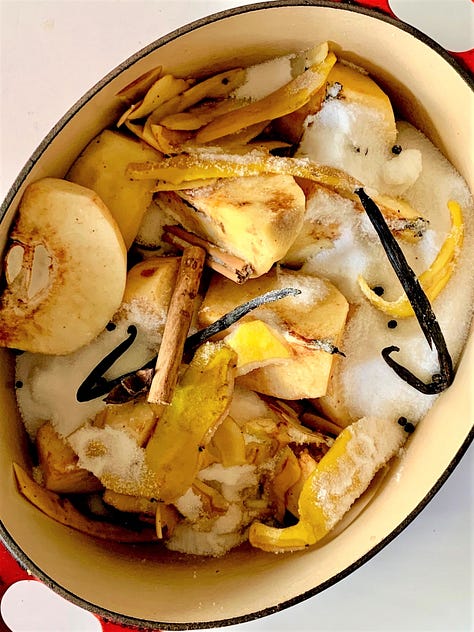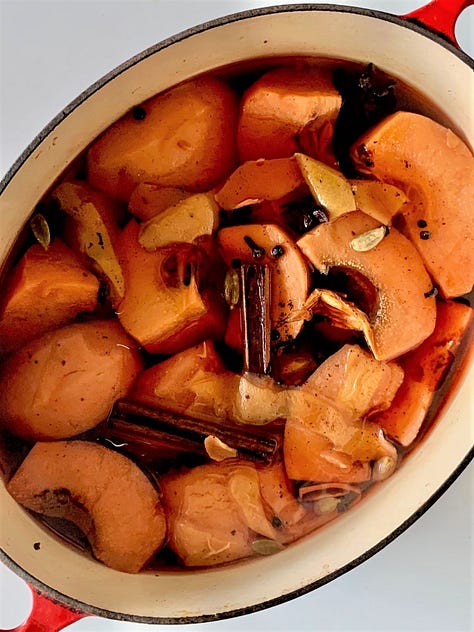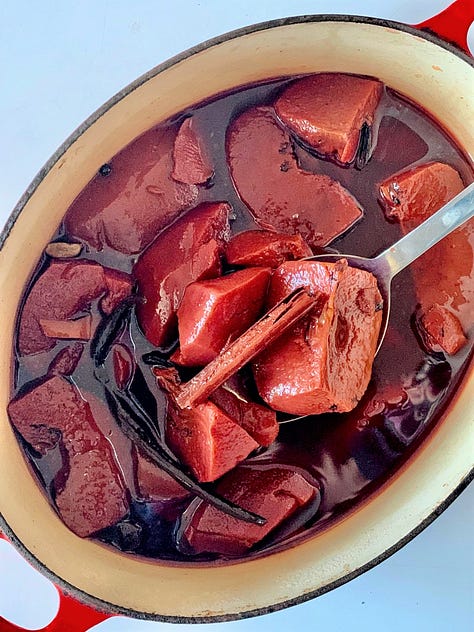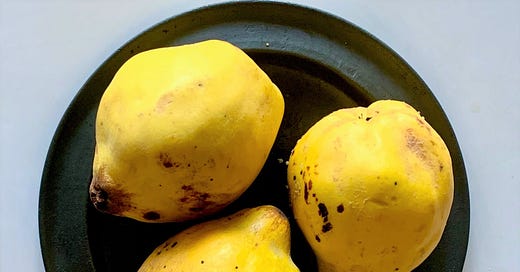Unlike any other fruit, quinces are particularly satisfying for the cook. Knowing you can turn something hard and astringent into something sweetly fragrant and rosy-cheeked all on your ownsome is pretty good stuff.
Quinces are one of the great pleasures of the cooler months. Great with roast pork and roast duck, plopped on top of French toast, or turned into a tarte tatin. Serve with a winter salad of watercress and gorgonzola, or with pumpkin in a tagine with couscous.
Or just make a quince upside-down cake or souffle, a steamed quince pudding, or pile them onto a rough hand-made galette of almond pastry. Equally good in the mornings with bircher muesli or porridge.
The equally incomparable Nigella has a technique for roasting quinces that looks fabulous, but I haven’t tried it yet. Check it out here.
And I’m here to remind you that chef Ross Lusted is in love with quinces so much that he named his Melbourne restaurant Marmelo (Portuguese for quince). If you go, check out the divine illustrations on the menu featuring our favourite winter fruit. If you can’t go, experience it vicariously with this review in the AFR. (Not sure if there is a paywall - if so, sorry).
QUINCE TIPS:
Cook them long and slow, and don’t rush them. Cook them too quickly and they will soften too much, and never develop that rich, ruby colour you need.
All you need is water, sugar, spices and time. Leave it until the weekend, put them in a slow oven in the morning, take them out six or seven hours later, and eat your way through them all week. TIME LAPSE:



In the process, the colour of the flesh changes from pale yellow to a deep burgundy, and the flavour mellows to a sort of gently sour plumminess that is quite unlike anything else. As a cook, that’s a very satisfying outcome.
NEED TO KNOW
# Quinces smell so good. Buy them a few days before you cook them so you can inhale every time you walk into the kitchen.
# Cook with core and seeds intact for the pectin – a natural setting agent - and add the peeled skins back in. It all helps to create a beautiful syrup.
# Quinces don’t like to be bothered. Once they’re in the oven, leave them alone. Do not stir, turn or otherwise interfere, or they may go a bit mushy.
# The syrup you end up with is GOLD. Drizzle over tarts, ice-creams and cakes. Add a spoonful to a negroni, dry martini, gin and tonic, or just sparkling water.
SPICED QUINCES
4 medium yellow quinces
400g sugar, brown or otherwise
2 cinnamon sticks
2 vanilla beans, split lengthwise
2 star anise
1 tsp peppercorns
4 cloves
Heat the oven to 120C.
Rub the skins of the quince to remove any down and trim off the ends.
Cut the fruit in quarters and peel, reserving the peel and leaving the core intact.
Combine sugar, cinnamon sticks, vanilla beans, star anise, peppercorns, cloves and 1.2 litres water and bring to the boil.
Add the quinces and reserved peel, cover tightly and bake for 6 hours, without moving or turning the fruit.
Check for doneness - a skewer should move easily through the flesh, yet they should retain their shape. For more colour, push it for another half hour or hour.
Remove and allow to cool, then gently remove the quince.
Cut out and discard the core and seeds.
Strain the juices into a pan (fish out the cinnamon and star anise and reserve) and simmer on high for a good ten minutes (keep an eye on it) to reduce and intensify.
Cool and return the quinces, cinnamon and star anise to the reduced syrup.
Serve the quinces and syrup, cool or reheated, in any way imaginable. Serves 4.
Thanks for dropping by! And thanks for your comments and suggestions, as always. Special thanks to Terry for finding the last remaining cinnamon sticks in the spice drawer.
At the mo, I am floating around the Aegean/Mediterranean (did you know the waters of one meet the waters of the other directly south of the island of Rhodes? I did not. Yet that is where I am right now, writing this). So this is an updated repurposing of a distant post that is still highly seasonal, because that’s what seasons do - they come around again and again with the same stuff. Like me. I bet none of you remember seeing it before anyway, so I don’t know why I am being so honest.
I would like to acknowledge the traditional owners of the lands and waters upon which I work, live, cook and play; the Gadigal people of the Eora Nation. Thank you for sharing your culture, traditions, knowledge, spirit, art, music, humour and food traditions, allowing us all to experience a sense of belonging in this ancient land.







I feel like Mum is saying hello. Thank you for this beauty Jill.
Quinces have long been my muse( paint or draw, as well). Only extra tip is that you can even just wipe the skin and leave peeling till later too. You’ve inspired me to make another lot- second this season.